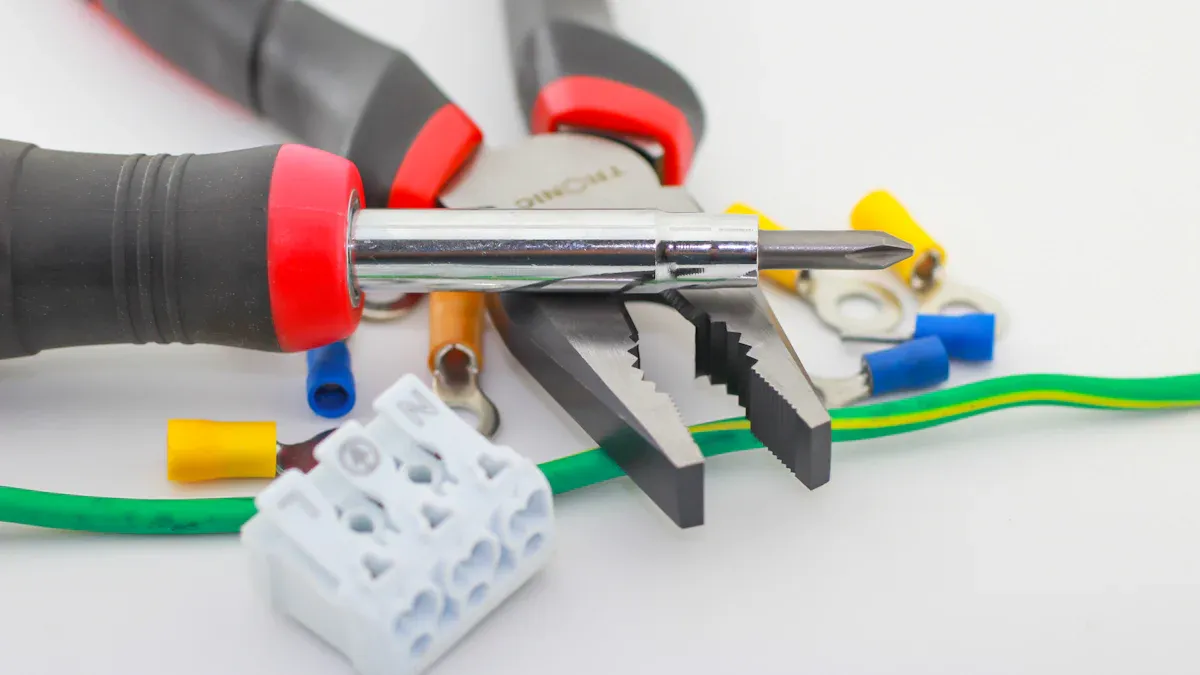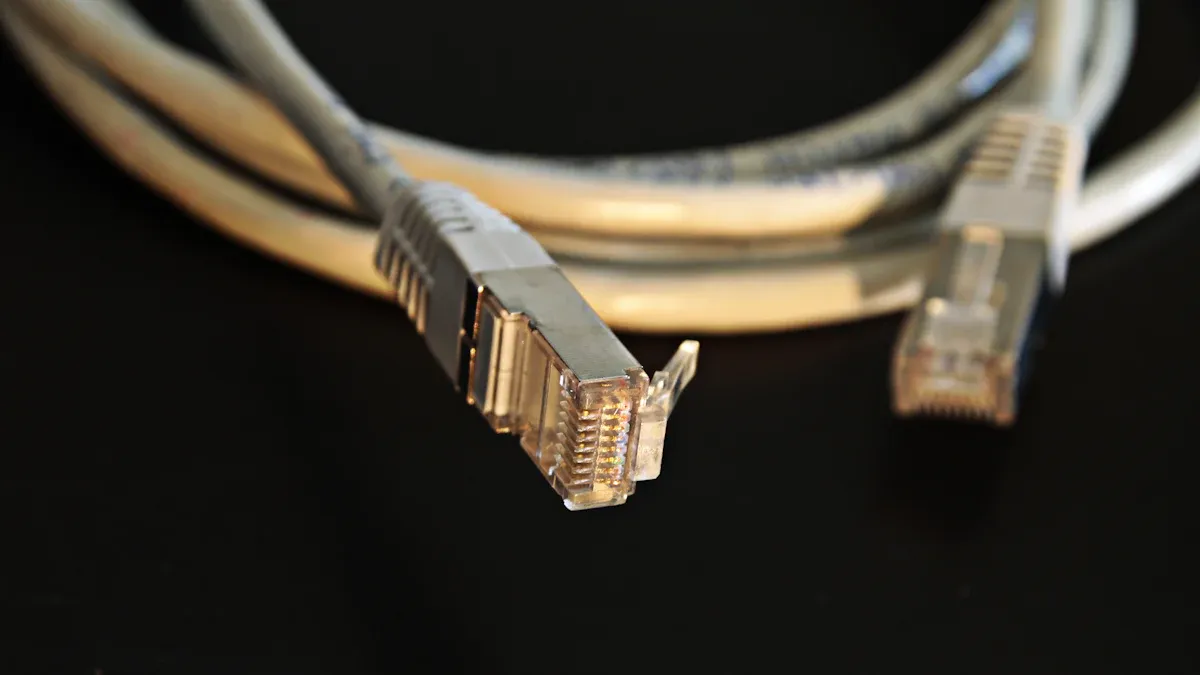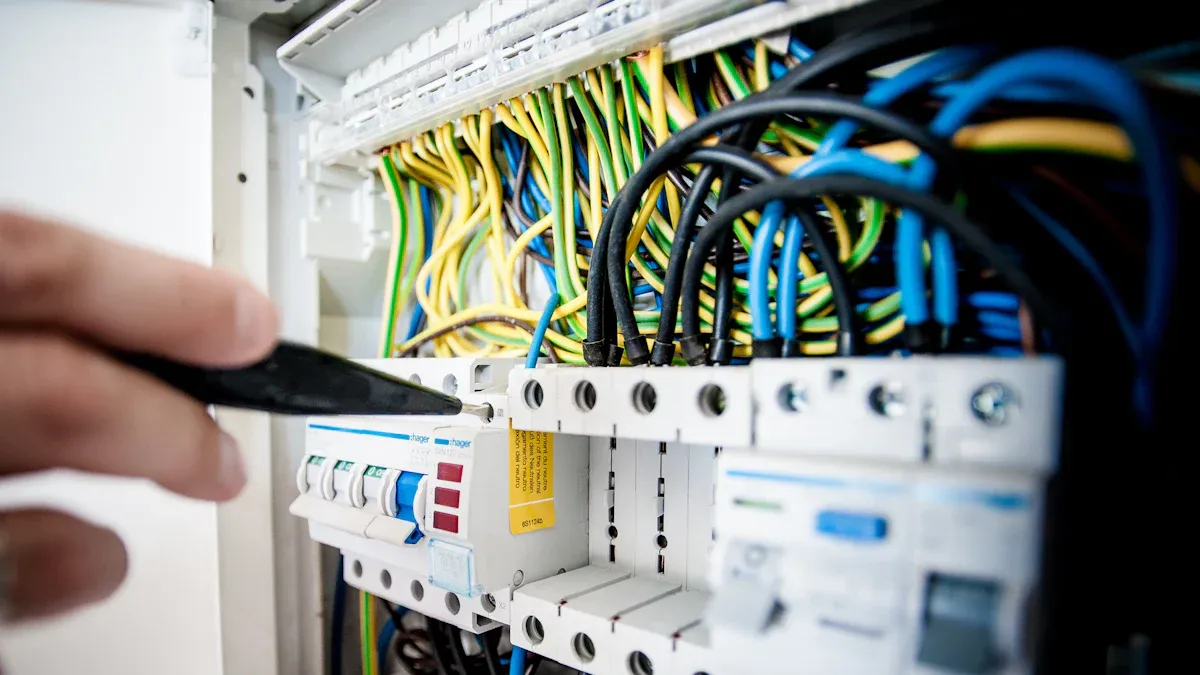Manufacturer Of High Quality Data Cable
Manufacturer Of High Quality Data Cable

Choosing the right wire connector types is very important for safety. It also helps with efficiency and keeps electrical systems working well. Picking the wrong wire connector type can cause overheating or even fires. For example, in car lights, good waterproof wire connector types keep out water. This makes parts last longer and lowers fire risks. Always pick a wire connector type that matches the wire type. Tighten it properly to stop it from coming loose or overheating. This keeps the circuit safe. There are many wire connector types to choose from. Knowing your needs and environment helps you pick the best one.
l Picking the right wire connector is important for safety. It stops overheating and lowers the chance of fires.
l Different connectors are made for specific jobs. Knowing your project needs helps you pick the right one.
l Good-quality connectors save money in the long run. They cut down on repairs and energy waste, making systems work better.
l Think about the environment when choosing connectors. Waterproof and strong ones are best for outdoor or tough conditions.
l Taking care of wire connectors makes them last longer. Look for damage and clean them to keep things working well.
Wire connectors are very important in electrical systems. They help wires stay connected securely and safely. This keeps wiring systems working well and prevents problems. For example, in lighting setups, they stop wires from coming loose. They also keep wires insulated to avoid overheating or fires. Wire connectors handle stress and keep electricity flowing smoothly. This makes them necessary for electrical devices to work properly.
There are different types of wire connectors for various uses. Here are some common ones:
l Twist-on wire connectors: These are used in homes. They twist wires together and are simple to use.
l Crimp connectors: These have a metal sleeve that is pressed onto wires. This creates a strong connection.
l Screw terminal connectors: Wires go into a block and are tightened with screws. These are good for permanent setups.
l Push-in wire connectors: Wires are pushed into a lock without needing tools. This makes them quick to install.
l Waterproof connectors: These are for outdoor or wet places. They stop rust and last a long time.
l Heat-shrink connectors: These work in hot areas and give extra protection and insulation.
Each type has a special use. Knowing what you need helps you pick the right one.
When picking wire connectors, look for key features. First, check if the connector fits your wire size. This ensures it works with your wires. Next, choose durable materials that last a long time. Strong connectors can handle wear and tear. Easy-to-use designs make installation faster and less tiring. For example, push-in connectors don’t need twisting, which saves effort.
By focusing on these features, you can choose connectors that improve safety and efficiency in your projects.
Wire connectors are simple and quick to install. They make joining wires easier, even for beginners. Push-in connectors let you connect wires without tools. This saves time and effort. Unlike old methods like soldering, they can be unplugged and reused. This makes fixing problems faster and easier. Many connectors also have color codes or labels. These features help you install them correctly without mistakes.
Wire connectors make electrical systems safer and more reliable. They keep wires secure, stopping overheating or short circuits. Manufacturers test them to ensure they work well. Below is a table showing some of these tests:
|
Test Name |
Purpose |
|---|---|
|
Insertion and removal test |
Ensures easy use while staying secure. |
|
Durability test |
Checks how long the connector lasts. |
|
Insulation test |
Confirms it prevents electrical problems. |
|
Vibration test |
Tests stability in moving environments. |
|
Shock test |
Checks strength against sudden impacts. |
|
Temperature test |
Tests performance in extreme heat or cold. |
|
Corrosion test |
Checks durability in harsh conditions. |
These tests show why connectors are trusted for safety. For example, sealed connectors work well in tough environments. They last long and handle harsh conditions.
Wire connectors work in many industries and projects. They are used in cars, electronics, and communication systems. For example, rectangular connectors are small and strong, perfect for cars and gadgets. Coaxial connectors are great for high-speed signals, like in 5G networks. Here’s a table with more examples:
|
Connector Type |
Where It’s Used |
Why It’s Useful |
|---|---|---|
|
Rectangular Connectors |
Cars, Electronics |
Small size, strong connection |
|
Coaxial Connectors |
Telecom, Broadcasting |
Handles fast signals, supports 5G |
|
Board-to-Board Connectors |
Special designs for unique needs |
High data speed, fits specific industries |
Special connectors, like waterproof or heat-shrink types, handle unique jobs. They work well outdoors or in hot places. This variety means you can always find the right connector for your project.
Wire connectors are a smart way to save money. At first, they might seem expensive, but they save more later. Using the right connectors prevents electrical problems. This means fewer repairs and less money spent over time.
Good connectors last longer and work better. For example, waterproof ones stop water damage and rust. This keeps your system working for years without needing replacements. Reliable connectors also reduce downtime. When systems run smoothly, you save on repair and labor costs.
Some connectors, like push-in types, can be reused. You can take them out and use them again without harm. This is great for projects that need changes often. Instead of buying new ones, you reuse what you have.
Wire connectors also help save energy. Strong connections stop energy loss, lowering your power bills. Over time, these savings add up. For businesses, this can mean big cost cuts in large operations.
Picking the right connector gives you the best value. Whether for home or work, the right choice saves money in the long run.
Wire connectors can sometimes cause signal problems. If they are not made or installed well, they might block electricity or data flow. This is common in things like communication systems or audio devices. Bad connectors can create resistance, which weakens signals or adds noise.
Weather and dirt can also hurt performance. For example, outdoor connectors may rust in bad weather. Rust makes interference more likely and lowers system reliability. To prevent this, pick connectors with strong materials and good insulation.
Wire connectors can be too big or too small for some devices. In gadgets like phones or tablets, connectors must fit in tiny spaces. But smaller ones might not last long or work as well.
In factories, large connectors take up too much room. This can make wiring messy and hard to manage. To fix this, choose connectors that are small but still strong. These work best in tight spaces.
Some wire connectors are tricky to use in certain jobs. For example, special connectors in factories or hospitals need careful setup. If they are not aligned right, the system might fail.
Different jobs need different connectors. Car connectors must handle heat and shaking. Medical ones need to be very precise. Below is a table showing challenges in various uses:
|
Challenge Type |
Details |
|---|---|
|
Design |
Shapes and sizes must fit needs while staying stable. |
|
Electrical Work |
Good connectors stop signal loss and handle high power. |
|
Strength |
Must stay connected in places with shaking or impacts. |
|
Small Gadgets |
Tiny connectors are needed for portable devices like phones. |
|
Factory Use |
Must resist dust and shaking in busy factory setups. |
|
Car Electronics |
Must survive heat and block signal problems in vehicles. |
|
Medical Tools |
Need to be very reliable and accurate for safety. |
Knowing these challenges helps you pick the right connector. Using the right tools and learning proper methods can make installation easier and safer.
Wire connectors can have problems with maintenance and durability. Over time, using them a lot can wear them out. For example, plugging and unplugging often can weaken the contacts. This can cause more resistance, leading to overheating or signal issues. Dirt from wear can also build up and hurt performance. Tiny particles can gather and make systems work less effectively.
Different connectors last for different amounts of use. The table below shows how many times common connectors can be used:
|
Connector Type |
Mating/Demating Cycles |
|---|---|
|
Series II Connectors |
250 Cycles |
|
Class J and M Connectors |
1500 Cycles |
|
All Other Connector Types |
500 Cycles |
Some connectors are stronger and last longer than others. Picking the right one can lower maintenance and make systems more reliable.
The environment also affects how long connectors last. Dust, water, and extreme heat or cold can damage them. Outdoor connectors might rust if they aren’t sealed well. Rust can block electricity and cause system failures. To avoid this, choose connectors made for tough conditions.
Taking care of connectors helps them last longer. Cleaning and checking for damage can keep them working well. But this can take a lot of time, especially with many cables. Using connectors with self-cleaning or rust-proof features can save effort.
By knowing these issues, you can choose and care for connectors better. This keeps your systems working safely and efficiently for a long time.

Banana connectors are simple and often used in audio systems. They are easy to plug and unplug, making them convenient. Their banana-like shape helps them fit tightly into sockets. These connectors are common in speakers to keep wires connected securely.
One big advantage is they are easy to use. You don’t need tools to set them up. They work well for low-power systems but not for high-power ones. Vibrations can loosen them over time, hurting performance. They work best in places where stability isn’t a problem.
In-line connectors join wires in a straight line and are versatile. They are used in factories and electronics because they save space. These connectors are modular, meaning you can add or change parts easily.
Here’s a table showing their pros and cons:
|
Advantage/Disadvantage |
Description |
|---|---|
|
Easy to use |
Quick to insert and remove for fast setup. |
|
Reliable |
Strong connection when soldered properly. |
|
Modular design |
Lets you change or expand setups easily. |
|
High-density connection |
Fits many wires in small spaces. |
|
Fast production |
Speeds up work in factories. |
|
Repairable |
Broken parts can be replaced without changing everything. |
|
Space issues |
Big connectors may not fit small areas. |
|
Pin limits |
Few pins may not work for complex systems. |
|
Soldering skills needed |
Requires practice for good connections. |
|
Wear from repeated use |
Using them too much can weaken the connection. |
|
PCB support needed |
Needs good PCB design for best results. |
In-line connectors are great for reliable and flexible projects. But they can be tricky for beginners because soldering is required.
Cordsets combine cables and connectors into one unit for easy use. They come pre-made, saving time during installation. You don’t have to match cables and connectors because manufacturers do it for you.
Cordsets are affordable since no special tools are needed. They are also dependable, working well for machines and outdoor gear. Here are some benefits of cordsets:
l They save time by removing the need to match parts.
l They are ready to use, so setup is simple.
l Manufacturers ensure they are high-quality and long-lasting.
Cordsets are a great choice for quick and reliable wiring solutions.
Push-in connectors make connecting wires easy and tool-free. You simply push the wire into the connector. These connectors are fast and simple to use. They are common in homes, businesses, and factories where quick setups are needed. Their design holds wires tightly, preventing loose connections.
A big advantage of push-in connectors is saving time. Unlike soldering or twisting wires, they let you finish faster. They also reduce hand strain during big jobs. For example, electricians often use them for lights because they speed up the work.
But push-in connectors don’t work well everywhere. They are best for solid wires and may not hold stranded wires unless specially made for them. They might also loosen in places with a lot of shaking or movement.
Terminal blocks help organize and connect many wires neatly. They are reliable and keep wires secure. You’ll find them in control panels, machines, and automation systems.
These connectors are great for jobs needing strong and lasting connections. Push-in terminal blocks, for example, hold wires better than screw types. They are perfect for setups that don’t need much maintenance. Their small size allows more wires in tight spaces. They are often used in sensors and automation systems.
Tip: Always strip wires to the right length when using terminal blocks. This helps make a good connection and avoids electrical problems.
Picking the right connector depends on your needs. The table below compares two popular options:
|
Feature |
IDEAL Twister® ProFLEX™ |
IDEAL Twister ProFLEX Max |
|---|---|---|
|
Wire Range |
Widest in the industry |
345 UL-approved combinations |
|
Durability |
High-quality materials |
1000V voltage rating |
|
Comfort |
Ergonomic design |
Swept wings for better grip |
|
Ease-of-Use |
Push-ins and lever connectors |
Fast installation without twisting |
This table shows the strengths of each type. If you want something easy to use, ProFLEX Max is a good choice. It installs quickly without twisting. If you need flexibility, ProFLEX works with more wire types.
By knowing these features, you can pick the best connector for your project.

Start by knowing what your project requires. Think about the type of connection needed. High-power systems need strong connectors for heavy loads. Low-power setups can use simpler connectors. Check the wire size too. If the connector doesn’t fit the wire, it may fail.
Make sure the connector works for your project. Push-in connectors are great for quick jobs. Screw terminal connectors are better for permanent setups. Look for safety marks like UL or CE. These show the connector is safe and high-quality. This helps avoid problems and makes the connection last longer.
The environment affects which connector you should pick. Outdoor projects need connectors that handle water, heat, and sunlight. Look for ratings like IP68 or NEMA for tough conditions. Waterproof connectors are good for outdoor lights. Heat-shrink connectors work in hot places.
Indoor projects need less protection but still face dust and shaking. Strong materials like nylon or polycarbonate help here. Picking the right connector for the environment makes it last longer and work better.
Testing is important when choosing a connector. Tests check how well it works under stress. Vibration tests make sure it stays stable when moving. Salt spray tests check if it resists rust outdoors.
Think about how strong the material is. Connectors near chemicals or heat need to be tough. UV-resistant materials are best for outdoor use. By checking these things, you can pick a connector that works well and fits your project’s needs.
Picking wire connectors means finding a balance between cost and quality. You don’t want to spend too much, but you need connectors that work well. Good-quality connectors might cost more at first, but they save money later. They last longer and need less fixing or replacing.
First, think about what your project needs. For small, simple jobs, cheaper connectors might be fine. But for tough environments or high-power systems, stronger, better connectors are worth it. They handle stress better and stay reliable longer than cheaper ones.
Check the materials used in the connectors. Cheaper ones may use weak plastics or metals that break easily. High-quality connectors often use strong materials like nylon or rust-proof metals. These materials make them safer and more durable.
Also, think about long-term costs. Cheap connectors might save money now but could fail often. This means more repairs and downtime, which costs more in the end. Spending a little more on good connectors can avoid these problems and keep things running smoothly.
Tip: Choose connectors with labels like UL or CE. These show the product is safe and works well, giving you better value for your money.
By balancing cost and quality, you can pick connectors that fit your needs and budget. This helps your projects stay safe, efficient, and long-lasting.
Picking the right wire connector keeps your projects safe and reliable. Different connectors have their own perks, like being easy to use or lasting longer. But they can also have problems, like being too big or needing upkeep.
Tip: Choose a connector that fits your project and surroundings.
Think about what you need and learn the pros and cons. This helps you save money and time while making your electrical systems work better and stay safe.
A downside is they might cause signal problems. Bad connectors or wrong setup can weaken signals and hurt system performance.
Choose connectors that are waterproof or weatherproof. Look for IP68 ratings or materials that resist rust and sunlight. These features help them last in tough weather.
Yes, some connectors, like push-in ones, can be reused. They let you connect and disconnect wires without breaking, which is great for projects needing changes.
Not all connectors work for high-power setups. Use connectors like screw terminals or crimp types that handle heavy loads safely.
Check connectors often for damage, rust, or dirt. Clean them carefully and replace broken ones. For outdoor connectors, make sure seals stay tight to block water and dust.